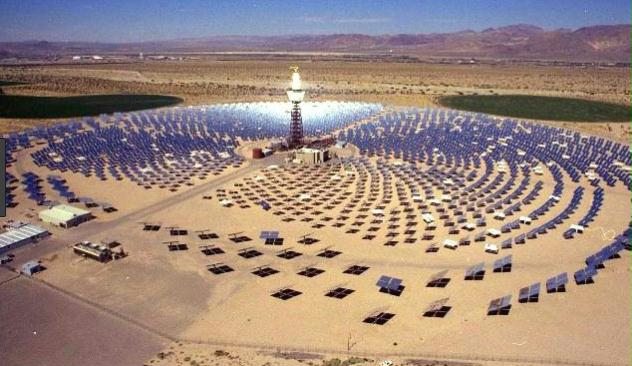
What follows is my summary of:
Bracken, N., et al. 2015. Concentrating solar power and water issues in the U.S. Southwest. U.S. department of energy, National renewable energy lab.
Alice Friedemann www.energyskeptic.com author of “When Trucks Stop Running: Energy and the Future of Transportation”, 2015, Springer and “Crunch! Whole Grain Artisan Chips and Crackers”. Podcasts: Derrick Jensen, Practical Prepping, KunstlerCast 253, KunstlerCast278, Peak Prosperity , XX2 report
***
Concentrated Solar Power plants can only be built in desert regions with huge amounts of direct sunlight. But these are usually the most water scarce regions in the nation and nearly all of them are in the deserts of Arizona, California, and Nevada.
CSP requires water in construction, the steam cycle, process cooling, and cleaning of solar collectors or mirrors.
If the grid were ever to become 100% renewable, CSP would play a key role, because it can be built with thermal storage to keep the grid up long after the sun goes down.
However, only one CSP plant of 39 has thermal storage, so this probably won’t happen. And at a billion dollars per plant not many more are likely to be built either (i.e. the 392 MW Ivanpah cost $2.2 billion on 3,600 acres). At $7,100/kW per CSP plant, it’s much cheaper to build natural gas ($1,100), Solar PV ($2,900), or coal ($3,600) electricity generating facilities.
No wonder only 0.03% of electricity is generated using CSP.
Yet CSP in a fossil-free world will be essential to generate the very high heat needed in manufacturing, much of it steam heat which requires enormous amounts of water. The only other source of non-fossil, renewable high heat is charcoal from wood.
The following industries need heat of up to 3275 F: Chemicals, Forest products, Iron and Steel, Plastics & Rubber, Fabricated metals, Transport Equipment, Computers, electronics & equipment, Aluminum, Cement, Glass, Machinery, Foundries. For most of these products, there is no alternative electric process.
The only industries that can get by without high heat are the food, beverage and textile industries.
Though water alone is a showstopper, it’s also equally unlikely that industries across America would move to the desert Southwest to build factories even if there were plentiful water.
It is also questionable how sustainable this is. How long would these aquifers last? There would be very little recharge at just a few inches of rain a year, limiting how much water can be withdrawn sustainably.
Siting a CSP plant is difficult, because most of the suitable land is federal, and it can take quite a long time to get permission to build on protected federal land. It’s also hard to get permits for water in these dry regions, since cities and agriculture are usually considered to be more important and CSP competes with agriculture for level land with less than a 1% slope. CSP locations are far from rivers and lakes, making groundwater the only possible source of water. In Arizona, it is hard to get permission to obtain groundwater without a grandfathered water right on that land or get a special permit in many regions.
Current estimates indicate that operational CSP plants use at least 620 acre-feet per year. That’s 765,000 cubic meters of water, 202 million gallons in the desert regions of the Southwest (Arizona, California, and Nevada).
CSP facilities with wet cooling can consume more water per unit of electricity generated than traditional fossil fuel facilities using wet cooling.
If all of the expected CSP projects are completed, most will be wet-cooled and require 221,000 acre feet a year, with dry-cooled using 18,000 acre feet per year. Because wet-cooled plants use so much more water than dry-cooled, California and Nevada have tried to limit them, and Arizona may well do so as well. So 9 of the 15 future CSP projects under construction will be dry-cooled, hybrid-cooled, or use reclaimed water.
But wet-cooled plants are more efficient than dry-cooled, and dry-cooled electricity generation drops off at temperatures above 100°F when generation is needed the most to meet summer peak electricity demand. Dry-cooled plants also need to employ massive cooling fans to remove heat from the pipe array since air has far less ability to lower heat than water does. These fans consume electricity being generated at the CSP plant, which not only subtracts from the amount of energy generated, it reduces the thermal efficiency of the steam turbines.
If significant amounts CSP power generated were transmitted to other states, the result would be a virtual export of scarce water to other states.
Related post:
Concentrated Solar Power: Water Constraints
References
CRS. 2009. Water Issues of Concentrating Solar Power (CSP) Electricity in the U.S. Southwest. Congressional Research Service.
USGAO. September 2012. ENERGY-WATER NEXUS. Coordinated Federal Approach Needed to Better Manage Energy and Water Tradeoffs GAO-12-880 U.S. Government Accountability Office.

One Response to Concentrated Solar Power can only exist in deserts and use too much water